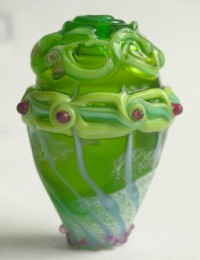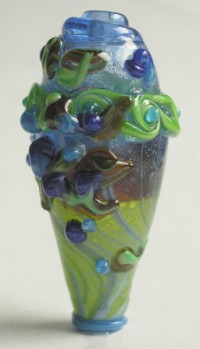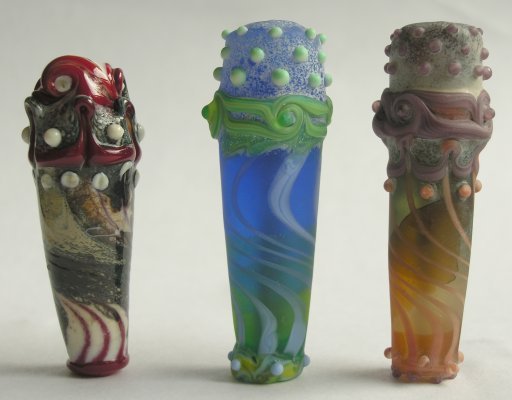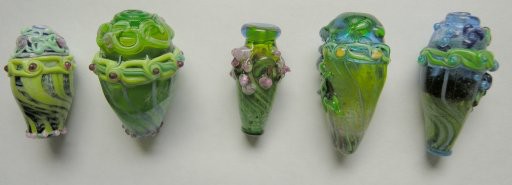Last winter I was lucky enough to take a class with Jennifer Geldard. Along with a class with Stevi Belle that I took about the same time, this was the first time I'd taken a class since a ‘for fun’ class with Page from Lisa St. Martin: I took the bulk of my classes in the first 2–4 years of making beads, and then figured it was time to start digesting the material. —I'm still digesting it, but the opportunity came up, and I had a great time.
I loved both classes, but I'd seen demos of Stevi's work before (so I was somewhat familiar with her working techniques) and Geldard's beads, particularly her ornamental series appealed to me, particularly the following:
- elongated vessel form
- transparent base
- thompson enamels; occasionally frits
- cased, twisted lengthwise stripes
- dot-twisted pairs of cased trails separating body & head or
- raked cased trails
- staggered rows of dots, usually on head
So I've been making these geldard-inspired vessels, off and on, since I took the class attempting to capture the elements I liked; most of them were not particularly handsome. (See below.) So I decided to copy her beads more closely, in hopes it would provide a greater understanding of her design process.
The red bead on the left was my effort to use copper as well as silver leaf, and it's basically a failure from a coloristic point of view—however, the style is more or less correct (this bead had a lot done to it, and was considerably better looking earlier on), and it stands up on its own: it was the reason I decided to go back to what I felt were original colors, concluding that I was so bad I couldn't even generate an original palette on my own. (Mixing copper and silver leaf to get this dark, antique surface was something we did in Stevi Belle's class.) Regardless of how they started all of these beads are solid.
Geldard updates her website regularly, and a particularly beautiful blue and green striped vessel persuaded me to try again: this time, by trying to copy her style, even the color combinations, as closely as possible, though I should note, Geldard generally uses less saturated versions of the blue and green than I chose here. (I was helped by the class notes I had made, which specified stringer color combos I thought likely for this piece.) I was especially pleased with the flecking of the transparent cobalt frit on top of the white thompson enamel on the head of the bead.
In fact, I only managed to copy half or 2/3 of it, but I was very happy; then I decided to try an original color combination. The dark line in the body of the third vessel comes from a chemical reaction between one of the hand-pulled pale brown (e.g. straw) colors and amber: I was attempting to do a subtle counter stripe, which failed. Nevertheless, I was very happy with the way this second ‘authentic’ vessel came outl. To my eyes it had the Geldard look, but in colors I hadn't seen her use.
Now let's take a look at what I've been doing.
The first vessel, on the left, uses (pea-green) opaque stringer, bad choices in background glass and is just plain ugly.

Number two is a little better: it incoporates cased stringer (probably white doublecased with czech denim and clear) on top of TE (pink as well as white) and three rows of trailing dot twisted into a sort of greek key pattern. The head of both beads is decorated with a floral pattern, similar to the pixie florals shown in another post. Though I didn't like the shape of this bead, I thought it was good enough to bother acid etching it, which Geldard does to many of her ornamentals.
The third bead only incorporates the dragged stripes on top of TE. It's pretty, but doesn't have enough Geldard motifs.
It is with the 4th and 5th beads that I finally felt I had begun to find a style that incorporated elements of what I really liked about Geldard's beads, but were beginning to differentiate themselves from her patterns. One of the difficulties of dragging stripes on hollow vessels is their tendancy to pop holes in thin spots; and this is what happened in bead #4. I was annoyed, but patched it and continued on. But the patch showed, and it was ugly. So I extended the floral decorations down into the body of the bead, covering the patch and incidentally crossing the trailing, which had served as a barrier. This was new. But not until several days later did I come up with a metaphor that justified this decision: ‘see,’ I told myself, ‘it looks like roses, spilling over a picket fence’. (There is a tendancy, when recounting the history of the creative process to tell these little verbal stories as if they came first, rather than after, as an explanation of what is often a totally non-verbal process.)

Of course, because I was experimenting, I wasn't paying proper attention to the heat base, and the rotten thing cracked all over. I heated it up enough to keep it together, figuring it could serve as a sample/bead curtain bead. Then I made another bead, and this time, since I had a good idea of how I wanted to make it, it only cracked once, in the body, and some gentle shoving with a knife patched it back together.
So, the big question, from an aesthetic, moral and financial point of view might be, are the new beads different enough? Particularly since Geldard also decorates the head of some of her long beads with florals, though she uses different techniques for the petals, and melts her designs in. So far, the financial aspect isn't an issue: I like my ‘close copies’ so well I'm keeping them, and the ‘spillover’ floral that concludes this post is a going-away gift for a neighbor who's moving.
Aesthetically, I'm pleased, after several months of periodic efforts, to finally be making some progress. However, I'd say I've still got a ways to go: though it's always impossible to say how far an idea (or series) will ultimately take one, it seems to me that I'm perhaps 1/3 –1/2 of the way of getting to something useable. Regardless, one of the fascinating aspects of art is that no matter where one is one the road, the end is never in sight, and it's rarely clear how far away it is: only that new goals will aways beckon.
I anticipate finding many more along this journey.
file originally created 15may05
Unless otherwise noted, text, image and objects depicted therein copyright 1996--present sylvus tarn.
Sylvus Tarn
